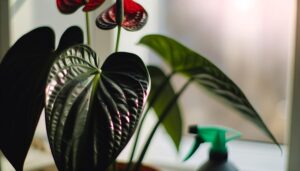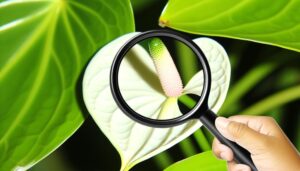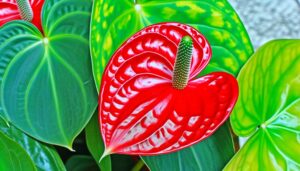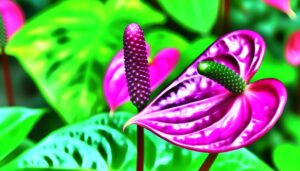Complete Guide to Caring for Anthurium Tickled Pink
To care for Anthurium 'Tickled Pink,' select a slightly larger terracotta pot with multiple drainage holes. Place in bright, indirect light; maintain 70-85°F and 70-80% humidity.
Water when the top inch of soil is dry using a well-draining mix of orchid bark, perlite, and peat moss. Fertilize moist soil with organic options like compost tea.
Prune with sterilized shears to remove damaged leaves and control growth. Inspect for pests like aphids and spider mites, applying neem oil as needed.
For disease prevention, use distilled water and monitor soil moisture. Discover detailed techniques to perfect your care regimen.
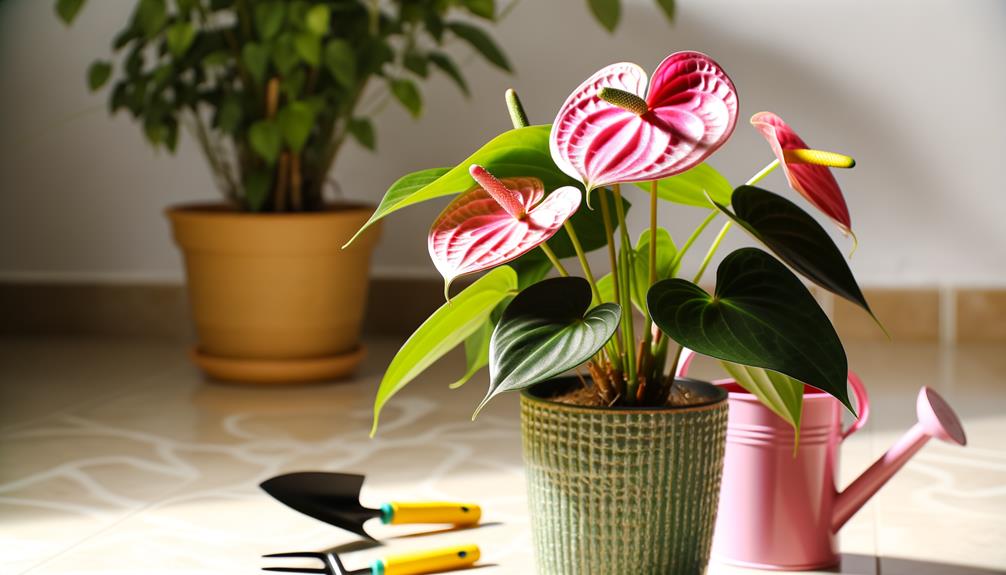
Key Takeaways
- Place Anthurium Tickled Pink in bright, indirect light and maintain a temperature range of 70-85°F.
- Water when the top inch of soil is dry, and use well-draining, slightly acidic soil with a pH of 5.5-6.5.
- Choose a pot with multiple drainage holes and a diameter 1-2 inches larger than the root ball.
- Apply organic fertilizers to moist soil and prune regularly to remove yellowing leaves and improve air circulation.
- Monitor for pests like aphids and spider mites, and use insecticidal soap or neem oil for treatment.
Choosing the Right Pot
Selecting the appropriate pot for your Anthurium Tickled Pink involves guaranteeing adequate drainage and choosing a size that allows for root expansion without causing waterlogging.
You'll want a pot with multiple drainage holes; this prevents root rot, a common issue in waterlogged environments. The pot's diameter should be 1-2 inches larger than the root ball to provide ample room for growth while maintaining soil aeration. Opt for materials like terracotta, which facilitate moisture evaporation. Avoid oversized containers, as they hold excess water, increasing the risk of fungal infections.
Prioritize a well-draining soil mix, incorporating components like perlite and orchid bark. This ensures peak root health, promoting vibrant foliage and prolific flowering. Proper pot selection is essential for your Anthurium's thriving growth.
Ideal Light Conditions
To maximize growth, position your Anthurium Tickled Pink in an area with bright, indirect light. Direct sunlight can scorch its leaves and impede photosynthesis. Ideally, place it near a north-facing window or behind sheer curtains in a south-facing window.
Light intensity should be around 10,000 to 20,000 lux to encourage optimal chlorophyll production without causing photodamage. Rotate the plant every few weeks to promote uniform light exposure and prevent etiolation.
If natural light is inadequate, supplement with full-spectrum LED grow lights, maintaining a photoperiod of 12-14 hours daily. Monitor leaf color and texture; yellowing or bleaching indicates excessive light, while dark green, leggy growth signals insufficient light.
Your attentive care guarantees robust, vibrant foliage.
Watering Schedule
To maintain peak hydration for your Anthurium Tickled Pink, water it once the top inch of soil feels dry to the touch.
Monitor for signs of overwatering, such as yellowing leaves and root rot, which indicate excessive moisture retention.
Guarantee well-draining soil to prevent water accumulation and promote healthy root development.
Optimal Watering Frequency
For best health, Anthurium Tickled Pink plants require a consistent watering schedule that maintains soil moisture without causing waterlogging.
Begin by watering your Anthurium when the top inch of the soil feels dry to the touch. Insert your finger into the soil to gauge moisture accurately. Utilize room-temperature, distilled water to avoid chlorine and fluoride damage. Ensure thorough watering until water drains from the pot's bottom, promoting even moisture distribution.
During the growing season, typically spring and summer, you'll need to water more frequently, approximately once a week. In contrast, reduce watering frequency to biweekly during fall and winter, as the plant's metabolic rate decreases.
Always monitor environmental humidity and adjust accordingly to maintain ideal soil conditions.
Signs of Overwatering
Overwatering an Anthurium Tickled Pink can lead to root rot, characterized by yellowing leaves, mushy stems, and a foul odor emanating from the soil. To diagnose overwatering, inspect the substrate: it should be moist but not waterlogged. Check the roots; healthy roots are white and firm, while affected roots turn brown and slimy.
Use a moisture meter to monitor soil hydration levels. Ensure the pot has adequate drainage holes to prevent water accumulation. Reduce watering frequency if these symptoms appear, allowing the soil to dry out between waterings. Maintain a balanced watering schedule, adjusting based on ambient humidity and seasonal changes.
This careful approach will preserve your Anthurium's health and prevent overwatering-induced stress.
Soil Requirements
When selecting soil for your Anthurium Tickled Pink, make sure it possesses a well-draining, aerated composition with a high organic matter content.
Aim for a slightly acidic pH level, ideally between 5.5 and 6.5, to optimize nutrient uptake.
Incorporate perlite or orchid bark to enhance drainage and prevent root rot.
Ideal Soil Composition
Anthurium Tickled Pink thrives best in a well-draining soil mix composed of equal parts orchid bark, perlite, and peat moss, providing ideal aeration and moisture retention.
To create this ideal environment, you'll need to focus on the following components:
- Orchid Bark: Enhances drainage, preventing root rot.
- Perlite: Increases soil porosity, ensuring sufficient oxygen reaches the roots.
- Peat Moss: Retains moisture while maintaining a light, airy structure.
- Optional Additive: Charcoal can be added to absorb impurities and keep the soil fresh.
Mix these elements thoroughly to create a balanced medium that mimics the Anthurium's natural habitat. By using this specific combination, you'll promote healthy root development and robust growth for your Anthurium Tickled Pink.
Ph Level Preference
For best development, make sure the soil pH for Anthurium Tickled Pink consistently falls between 5.5 and 6.5, which provides the slightly acidic conditions these plants prefer. To achieve this pH range, use a soil testing kit to monitor acidity levels regularly. Adjust the pH by incorporating acidic amendments like peat moss or sulfur if necessary. You can also use diluted vinegar for minor adjustments.
Avoid alkaline amendments, as they'll hinder nutrient uptake. Remember, maintaining this pH range ensures prime absorption of essential nutrients like iron and manganese, critical for vibrant foliage and blooms. Regularly calibrate your pH meter for accuracy, ensuring your Anthurium Tickled Pink thrives in its ideal acidic environment.
Your plant will reward you with lush, healthy growth.
Drainage and Aeration
Securing proper drainage and aeration is crucial to prevent waterlogging and root rot in Anthurium Tickled Pink, which thrive in well-draining, aerated soil mixtures.
You'll need to create an ideal substrate by blending organic and inorganic components that promote both moisture retention and sufficient airflow.
Here's a detailed soil recipe to follow:
- Orchid Bark: Provides aeration and emulates the plant's natural epiphytic environment.
- Perlite: Improves drainage and prevents soil compaction.
- Peat Moss: Retains moisture while offering some acidity.
- Charcoal: Enhances drainage and reduces harmful toxins.
Mix these components in equal parts to create a balanced medium.
Regularly check for compacted soil and repot as necessary to maintain peak root health.
This precise soil composition guarantees your Anthurium Tickled Pink will thrive.
Temperature and Humidity
Maintaining ideal temperature and humidity levels is important for the healthy growth of Anthurium Tickled Pink. Aim for a consistent temperature range between 70-85°F (21-29°C).
Avoid exposing your plant to temperatures below 60°F (15°C), as this can cause stress and stunt growth. High humidity is essential; try to maintain levels between 70-80%. Placing a humidifier nearby or using a humidity tray filled with water and pebbles will help.
Mist the leaves regularly but assure proper air circulation to prevent fungal issues. Monitor environmental conditions with a digital hygrometer and adjust as necessary.
Fertilizing Tips
After establishing a stable environment, you'll need to provide your Anthurium Tickled Pink with the right nutrients through a balanced fertilizing regimen.
To keep your plant thriving, follow these steps:
- Frequency: Fertilize every 6-8 weeks during the growing season (spring and summer) using a balanced, water-soluble fertilizer (20-20-20 NPK ratio).
- Dilution: Dilute the fertilizer to half the recommended strength to avoid root burn.
- Application: Apply the fertilizer to moist soil; never fertilize dry soil to prevent nutrient shock.
- Organic Options: Consider using organic fertilizers like compost tea or fish emulsion for a gentle nutrient boost.
Pruning Techniques
Regularly pruning your Anthurium Tickled Pink not only maintains its aesthetic appeal but also promotes healthier, more vigorous growth. Begin by sterilizing your pruning shears with isopropyl alcohol to prevent pathogen transmission.
Carefully examine the plant, identifying any yellowing or damaged leaves—these should be removed first. Cut at the base where the leaf meets the stem, ensuring a clean, precise incision to minimize stress.
Next, thin out any overcrowded areas, allowing better air circulation and light penetration. Always prune just above a node to encourage new growth.
Repotting Guide
Repotting your Anthurium Tickled Pink involves carefully transferring the plant to a slightly larger pot to accommodate its growing root system and promote maximum nutrient absorption. First, choose a pot that's 1-2 inches larger in diameter than the current one. Make sure it has drainage holes to prevent root rot.
Follow these steps to repot effectively:
- Prepare the new pot: Fill the bottom with a layer of coarse substrate, promoting adequate drainage.
- Remove the plant: Gently loosen the root ball, avoiding damage to the delicate roots.
- Inspect roots: Trim any blackened or mushy roots to maintain plant health.
- Position and fill: Place the plant centrally in the new pot, filling around it with fresh, well-aerated potting mix.
Common Pests
When caring for your Anthurium Tickled Pink, be vigilant for common pests such as aphids, spider mites, and mealybugs, which can compromise the plant's health. Regularly inspect the undersides of leaves and stems for these invaders. Use a magnifying glass for early detection and act promptly. Apply insecticidal soap or neem oil, ensuring thorough coverage on affected areas. Maintain ideal humidity and air circulation to deter infestations.
| Pest | Identification | Treatment |
|---|---|---|
| Aphids | Small, green insects | Insecticidal soap, neem oil |
| Spider Mites | Tiny, red dots | Neem oil, increase humidity |
| Mealybugs | White, cottony spots | Rubbing alcohol, neem oil |
Adopt a routine of cleaning leaves with a damp cloth to remove dust and check for early signs of pests.
Disease Prevention
To prevent diseases in Anthurium Tickled Pink, you should employ precise watering techniques to avoid root rot and fungal infections.
Implement pest control strategies to eliminate vectors that can transmit pathogens.
Regularly prune and maintain the plant to remove any diseased or damaged tissues, ensuring ideal plant health.
Proper Watering Techniques
Balancing the water level for your Anthurium Tickled Pink is crucial in preventing root rot and other moisture-related diseases. You need to balance moisture to maintain peak soil hydration while avoiding waterlogging.
Here's how to do it:
- Assess Soil Moisture: Use a moisture meter to check the soil's dampness before watering. The ideal range is slightly damp but not saturated.
- Watering Schedule: Water your plant when the top inch of soil feels dry. This usually means once a week, but it can vary depending on your surroundings.
- Drainage: Make sure your pot has sufficient drainage holes to prevent water stagnation.
- Water Purity: Use distilled or rainwater to avoid salt and mineral buildup, which can harm your Anthurium.
Pest Control Strategies
Effective pest control strategies are crucial in protecting your Anthurium Tickled Pink from common pests like aphids, mealybugs, and spider mites.
Begin by examining your plant weekly for early signs of infestations, such as honeydew residue or webbing. Use an insecticidal soap solution, applying it thoroughly to both the upper and lower leaf surfaces.
For persistent infestations, consider introducing beneficial insects like ladybugs or predatory mites, which naturally target these pests. Maintain ideal humidity levels around 60-80% to deter spider mites, which thrive in dry conditions.
Promote proper air circulation by spacing plants adequately. Finally, quarantine any new plants for at least two weeks to prevent introducing pests into your existing collection.
This vigilance keeps your Anthurium Tickled Pink flourishing.
Pruning and Maintenance
Why is regular trimming crucial in disease prevention for your Anthurium Tickled Pink?
Trimming reduces the likelihood of fungal and bacterial infections by promoting airflow and removing decaying plant material. You'll need sterilized trimming shears to mitigate the risk of cross-contamination.
Focus on cutting away dead or yellowing leaves, which can harbor pathogens.
Here's how you can effectively trim your Anthurium:
- Inspect regularly: Examine your plant once a week for discolored or wilted leaves.
- Sterilize tools: Use a 70% isopropyl alcohol solution to clean your shears before each use.
- Trim selectively: Cut leaves at the base, close to the stem, to prevent open wounds.
- Dispose properly: Discard trimmed material in a sealed bag to avoid spreading diseases.
Regular trimming promotes the well-being of your Anthurium, free from disease.
Seasonal Care Tips
During the growing season, monitor the Anthurium Tickled Pink's soil moisture closely to maintain it consistently damp but not waterlogged. Utilize a moisture meter to optimize hydration levels. In contrast, during the dormant season, reduce watering frequency to prevent root rot. Adjust fertilization schedules to align with the plant's growth cycle; apply a balanced, water-soluble fertilizer bi-monthly during active growth and cease during dormancy.
| Season | Care Tip |
|---|---|
| Spring | Increase watering frequency, keep soil damp |
| Summer | Maintain humidity, mist leaves regularly |
| Autumn | Gradually reduce watering, monitor humidity |
| Winter | Minimize watering, avoid cold drafts |
Pay close attention to temperature fluctuations, ensuring the plant remains in a stable environment between 60-80°F (15-27°C).
Conclusion
By adhering to these detailed guidelines, you'll guarantee your Anthurium Tickled Pink thrives. From selecting the right pot to managing pests, each step plays a vital role.
Don't underestimate the importance of maintaining ideal light, water, and soil conditions. With careful attention to temperature and humidity, can't you see your plant flourishing?
Regular repotting and disease prevention will further safeguard its health. Embrace these practices, and your Anthurium will reward you with vibrant beauty year-round.

